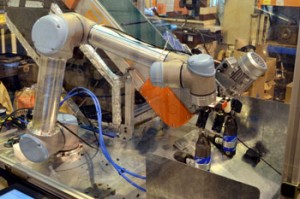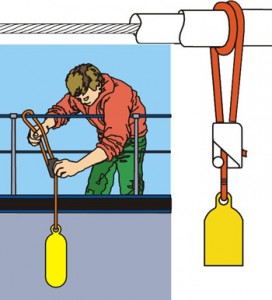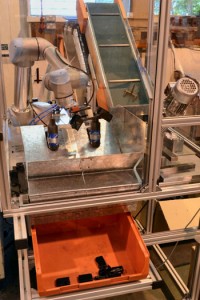Multi-application robot is easy to program
 When Hertfordshire-based Clamcleats needed a robot to automated the degating of injection moulded components for plastics rope cleats, but without the programming headache of traditional robotic solutions, it turned to RA Rodriguez.
When Hertfordshire-based Clamcleats needed a robot to automated the degating of injection moulded components for plastics rope cleats, but without the programming headache of traditional robotic solutions, it turned to RA Rodriguez.
Traditional robots can substantially boost productivity but generally they are large devices that are application-specific and complex to program. They need high production volumes to justify both capital cost and integration time. For a manufacturer new to robotics this can be off-putting and also uneconomical if products and batch sizes are many and various.
The solution for Clamcleats was the Universal Robot – a small, light weight industrial robot arm that has six axes of movement and above all is exceptionally quick and easy to install. A specially developed graphical user interface means no expert programming is needed. Within a couple of hours it can be ready to run. It is the ideal entry-level automation device that can be set up by anyone.
 The problem that drove MD Julian Emery to consider automating the de-gating process was initially focussed on the large cleats attached to comparatively thick runners. He explains: “There is an RSI risk with manually clipping these products when cold. To avoid this, our preference was to clip the runners when still warm and therefore relatively soft. But of course that put limitations on when we could run our injection moulding machines. Automation gives us much greater production flexibility.”
The problem that drove MD Julian Emery to consider automating the de-gating process was initially focussed on the large cleats attached to comparatively thick runners. He explains: “There is an RSI risk with manually clipping these products when cold. To avoid this, our preference was to clip the runners when still warm and therefore relatively soft. But of course that put limitations on when we could run our injection moulding machines. Automation gives us much greater production flexibility.”
Whilst a dedicated press was an option, the cost of the tooling involved for each type and size of cleat made it unviable. So Emery went in search of an alternative to do the job. “The Universal Robot stood out for me. As it didn’t need to be traditionally guarded we could apply it to a variety of applications. That flexibility made it a safe purchase. For example, it could equally be used to load or unload our CNC machines automatically without the need for over-the-top guarding.”
Initially however Clamcleats is focussing its attention on developing fixtures that enable the robot to grip product variations effectively. The company manufactures a wide variety of rope cleats for camping, leisure marine and sports application with 80% of its output produced for export. It also regularly adapts its designs to suit new application.
Light guard integration
As RSI risk was the main reason for the robot’s purchase, it is the larger cleats in production runs of around 2,000 that are taking priority. This is the task assigned to process engineer Steve Blease, who has worked closely with the RA Rodriguez to optimise production. One of their first tasks was to install a light guard, not to protect the workforce from the robot but pneumatic, fixed mounted clippers that automatically close on the gate of the runner to detach the part.
“Teaching the robot is child’s play, both Julian and I taught ourselves within a day. The teach mode is ideal for establishing the basic approach and then it’s just a question of fine-tuning for final positioning.”
Clamcleats required any interruption of the safety light curtain to result in an operational pause rather than an emergency stop, requiring re-set. A pause function is a standard option on the Universal Robot but nonetheless RA Rodriguez liaised with the curtain’s manufacturer, Keyence, to ensure efficient integration.
Currently the uncut parts are manually loaded onto the fixture and located on the sprue. The Universal Robot then transfers the tree-of-parts to the clippers. Having located on the runner, the robot sends a signal to the clippers to make the first cut. In sequence, each part is detached and deposited in to a collection chute and waste material is placed onto a mini conveyor for recycling.
Intuitive programming
“Teaching the robot is child’s play, both Julian and I taught ourselves within a day,” Blease comments. “The teach mode is ideal for establishing the basic approach and then it’s just a question of fine-tuning for final positioning.” Process simulation can be run in a choice of orientation and also at variable speed.
Although the positioning accuracy of the Universal Robot is ±0.1mm, the accuracy of cut is dictated by the efficiency of the fixture. Work is still continuing to make the fixture more robust to prevent the part twisting as weight and balance change. “This element of project is largely trial and error but as far as the robot is concerned, it has proved faultless,” Blease adds.
 Even at this early stage – and prior to dedicated training from RA Rodriguez – Clamcleats is deriving productivity benefits. These are mainly from the operator’s ability to multitask. Whereas the clipping process used to be a separate activity, it can now be accomplished automatically alongside quality checking and packing.
Even at this early stage – and prior to dedicated training from RA Rodriguez – Clamcleats is deriving productivity benefits. These are mainly from the operator’s ability to multitask. Whereas the clipping process used to be a separate activity, it can now be accomplished automatically alongside quality checking and packing.
Having reduced RSI risks by automated cutting, the company will soon turn its attention to the high volume products that are generally run in batch sizes of 10,000. Typically these are small cleats that are injection moulded in sets of 10 and ordered in huge volume by relief agencies attending the scene of a major disaster. Indeed Clamcleats is confident its Universal Robot investment will boost its ability to reduce lead times in this regard.
The robot is also mounted on a trolley in anticipation of it being moved next to the injection moulding machine, allowing Clamcleats to consider lights out production
Emery concludes: “Ultimately we plan to use the Universal Robot wherever we can in the factory. It is so easy to integrate and has potential not just in our rope cleat production but also for our trade moulding work too.”
Visit the RA Rodriguez website for more information
See all stories for RA Rodriguez















